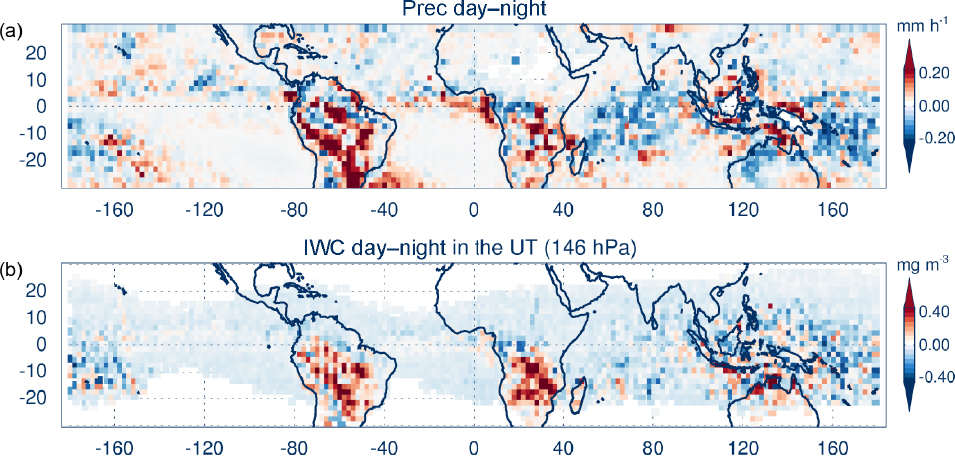Convective processes play a major role in controlling the abundances of cloud ice and water vapor in the tropical tropopause layer, which in turn strongly modulate climate. Despite their importance, these processes remain poorly represented in global climate models. Observations of the full diurnal cycle of cloud ice, closely linked to that of convection, are needed to enable model evaluation and refinement.
Measurements of ice water content (IWC) in the upper troposphere (UT, 147 hPa) and tropopause level (TL, 100 hPa) from the Aura Microwave Limb Sounder (MLS) show strong spatial correlation with measurements of precipitation (Prec) from the Tropical Rainfall Measuring Mission (TRMM) in the austral tropics during the convective season of December-January-February (DJF). Prec is shown to be a good proxy for deep convection reaching the UT and TL during the growing stage of convection. A simple model is developed combining the twice-daily MLS IWC with the higher temporal resolution TRMM Prec to reconstruct the diurnal variation of ice. The amount of ice injected into the UT and TL by deep convection (∆IWC) is estimated from the difference between the maximum and the minimum in the calculated diurnal cycle of IWC. A 13-year DJF climatology of ∆IWC with a horizontal resolution of 2 deg × 2 deg is produced for six tropical convective zones.

Climatological (2004–2017) December-January-February (DJF) day-night differences in (a) precipitation (Prec) measured by TRMM and (b) ice water content (IWC) measured by MLS in the upper troposphere (UT, 146 hPa) show strong spatial correlation, especially over land areas. Convective regions in the austral tropics such as South America, South Africa, the intertropical convergence zone (ITCZ), and the Maritime Continent are characterized by positive day-night values in both Prec and IWC during this season, consistent with greater injection of ice by deep convection into the UT during daytime in these regions.
Dion et al., Atmos. Chem. Phys., 19, doi:10.5194/acp-19-6459-2019, 2019
Scientific significance, societal relevance, and relationships to future missions:
Although clouds and water vapor in the tropical tropopause layer (TTL) play central roles in Earth’s climate system, the exact mechanisms controlling them are still not fully understood, and climate models continue to exhibit large spread in their ability to simulate associated processes. For example, it is well documented that many climate models fail to accurately reproduce the diurnal cycles of clouds and precipitation, which are closely coupled to the diurnal cycle in convection. Global measurements of relevant physical quantities are needed to evaluate model performance and identify deficiencies that can be used to guide refinements to improve the reliability of model projections. However, a lack of measurements of IWC over its full diurnal cycle has hampered these efforts. The simple model developed in this study exploits the long records from MLS and TRMM to produce a much more detailed view of the diurnal variation of ice in the TTL than achievable with the twice-daily MLS measurements alone. The climatological (2004–2017) picture of the amount of ice injected into the TTL during the austral convective season (DJF) with 2 deg × 2 deg horizontal resolution will enable detailed studies of the impact of tropical deep convection on the total water budget in the TTL in different regions and its relation to large-scale intraseasonal and interannual variations such as the Madden-Julian Oscillation and El Niño / Southern Oscillation (ENSO). The results of this study underscore the value of the continued long-term record of TTL IWC from Aura MLS and the need for future measurements that directly resolve the diurnal cycle of IWC in the TTL. The Decadal Survey’s Aerosol and Cloud, Convection and Precipitation (ACCP) observing system recommendation calls for future measurements of IWC, though possibly not its diurnal cycle.
Data sources:
Aura Microwave Limb Sounder (MLS) version 4.2 measurements of IWC, H2O, Temperature, and RHI
Precipitation data from TRMM
NCEP tropopause pressure
References:
Highlight slide compiled by : Michelle Santee, Jet Propulsion Laboratory, California Institute of Technology, Mail Stop 183-701, Pasadena, CA 91109
Citation: Dion, I-A., et al., Ice injected into the tropopause by deep convection – Part 1: In the austral convective tropics, Atmos. Chem. Phys., 19, 6459–6479, doi:10.5194/acp-19-6459-2019, 2019.
11.2019